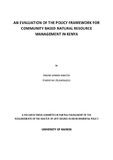| dc.description.abstract | This study was designed to assess international best practices in Community-Based Natural
Resource Management (CBNRM) and how these can inform policy and legal framework for
Kenya. It is premised that the CBNRM framework in Kenya is inadequate in making significant
contribution to community livelihoods or ensuring sustainable management of natural
resources. The study objectives were to (i) undertake a comparative analysis of international
CBNRM policies in three selected countries with best practices; (ii) review the policy, legal and
institutional framework for CBNRM in Kenya; and (iii) assess the challenges and opportunities
for the Ngare Ndare Forest communities under existing CBNRM framework.
Policies and laws in the natural resources sector for Namibia, Botswana, Philippines and Kenya
were analysed; and a case study of the Ngare Ndare forest community made. Ngare Ndare
forest is indigenous and traverses Meru and Laikipia Counties in northern Kenya. There are six
communities that live adjacent to the forest and utilize forest resources for their livelihood. The
communities are involved in CBNRM as provided for in sectoral laws, particularly forest, water
and wildlife. Purposive sampling was used to select community members who were then
interviewed, using an interview guide. Key informants including government officers and nongovernmental
organisations working in the sectors were also interviewed using interview
schedules. Primary data was categorized and analysed using a logical matrix.
The study found that Namibia, Botswana and Philippines have deliberate efforts in making clear
policy positions for CBNRM and thus provide international best practices. In Namibia, policies
for wildlife, forests, water and land specifically aim at incorporating CBNRM through provisions
for management and benefit sharing with communities in a well defined structure. In
Botswana, CBNRM is incorporated in development strategies including the National Policy for
Rural Development, the National Strategy for Poverty Reduction and Botswana Vision 2016. In
the Philippines, CBNRM is largely entrenched in the forest sector through the Environment and
Local Government Codes. Whereas the Kenya Constitution 2010 provides for CBNRM, policy
and legal provision remains inadequate. A number of policies, such as the Forest Policy (2007)
and the Water Policy (1999) acknowledge the need for community involvement in resources
management. However, none of these policies currently outlines the principles and practice for
vi
CBNRM in their respective sectors. The Ngare Ndare Forest case shows that there are multiple
and conflicting sectoral requirements. Communities have to register several institutions with
different requirements to suit different sectors. In addition, there seems to be lack of clear
direction within the government institutions on what CBNRM entails. Here, the Kenya Forest
Service has transferred responsibility to communities without shared decision-making or
economic benefits. The study concludes that: (i) a CBNRM policy should be developed to
provide a clear direction and strategies on its practice in Kenya; (ii) CBNRM should be adopted
as a development strategy in Kenya; and (iii) there is a need for consistency between policies
and laws in the natural resources sector. | en |

